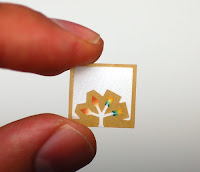Lab on a stamp
Lab on a chip, how common. How about lab on a stamp. Scientists at Harvard are experimenting with paper as a material for making tiny sensors. Paper is cheap and it turns out it can do a lot of things like separating different molecules. You've probably done some experiments looking at the way colors separate using paper like the one used to make coffee filters. Now add in some inks that are hydrophobic and can be used to direct liquids to different parts of the paper sensor and you are going a long way to make sensors that can test for different diseases. These cheap sensors will have a lot of use in developing countries.http://tiny.cc/w20oj
Posted by
Carl Batt
at
2/26/2010 11:35:00 AM
0
comments
![]()
![]()
Nanooze the exhibit opens at EPCOT, Walt Disney World
So it started as a web site, next a magazine and now an exhibit. On February 22, 'Take a Nanooze Break' opened at EPCOT Walt Disney World in Florida. The interactive exhibit has a number of opportunities for guests to explore the nanoworld and get a feel for things that are too small to see. The exhibit is on long term display located in Innoventions where new science and technology is showcased. You can sit and listen to stories about nanotechnology, play with a simple to use hand-held microscope, take molecules for a spin and zoom into the nanometer scale structure of a number of different common objects.
Posted by
Carl Batt
at
2/22/2010 08:41:00 PM
1 comments
![]()
![]()
Tiny layer of glass
Nanotechnology is all about making things small----and thin. So sometimes the magic is not making it tiny but making it incredibly thin, only a few atoms or molecules thick. The big thing about making thin things is making sure that even though it is thin, it is uniform, meaning no holes. And that is hard. Imagine spreading peanut butter just a few molecules thick? Tough. Now scientists have figured out how to make layers of glass only a few molecules thick. Glass is made of silicon dioxide and is pretty impermeable. A layer 15 to 30 molecules thick (about 1/500 the width of a hair) prevents bacteria from penetrating and so you could make a bacteria proof coating. It is also impermeable to water meaning it doesn't stain. What is neat is that glass at that thickness is transparent (well that is not surprising) but it is also flexible! Meaning you could coat lots of different things. Maybe you wouldn't want to eat it but it is might be useful for stain resistance or to make things really slick like the front end of a high speed train. http://tiny.cc/0uhtC
Posted by
Carl Batt
at
2/07/2010 07:32:00 AM
0
comments
![]()
![]()
Subscribe to:
Posts (Atom)




